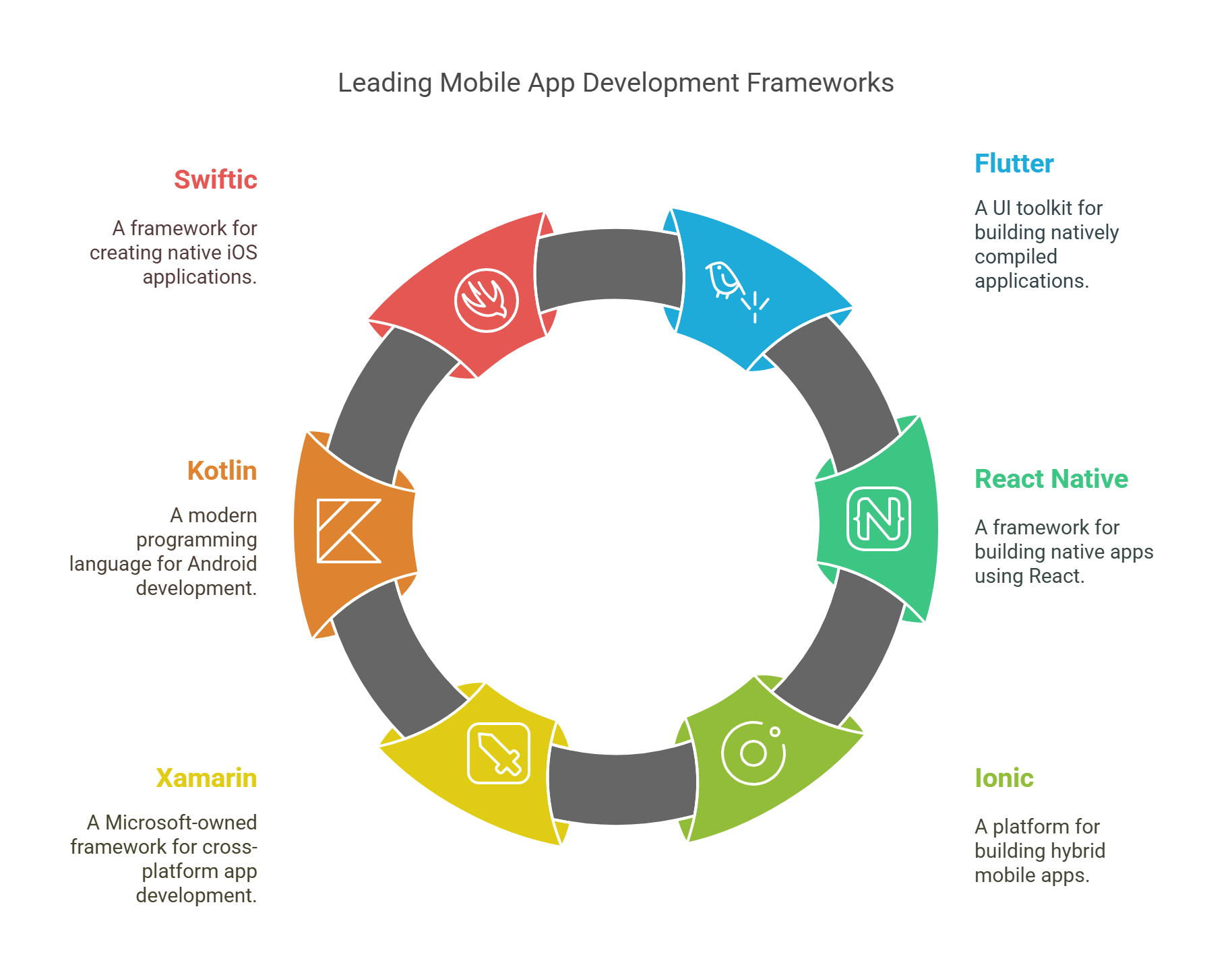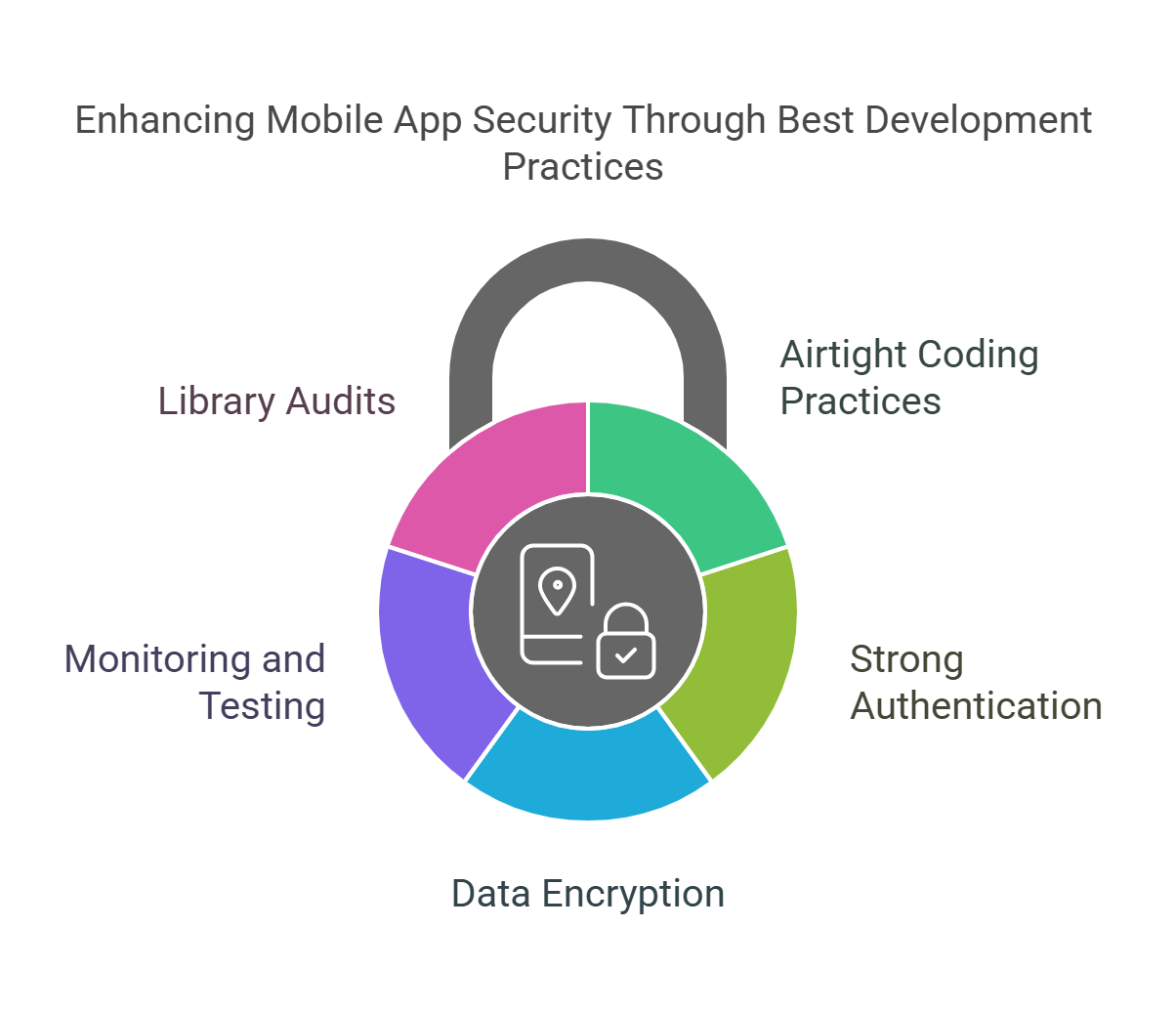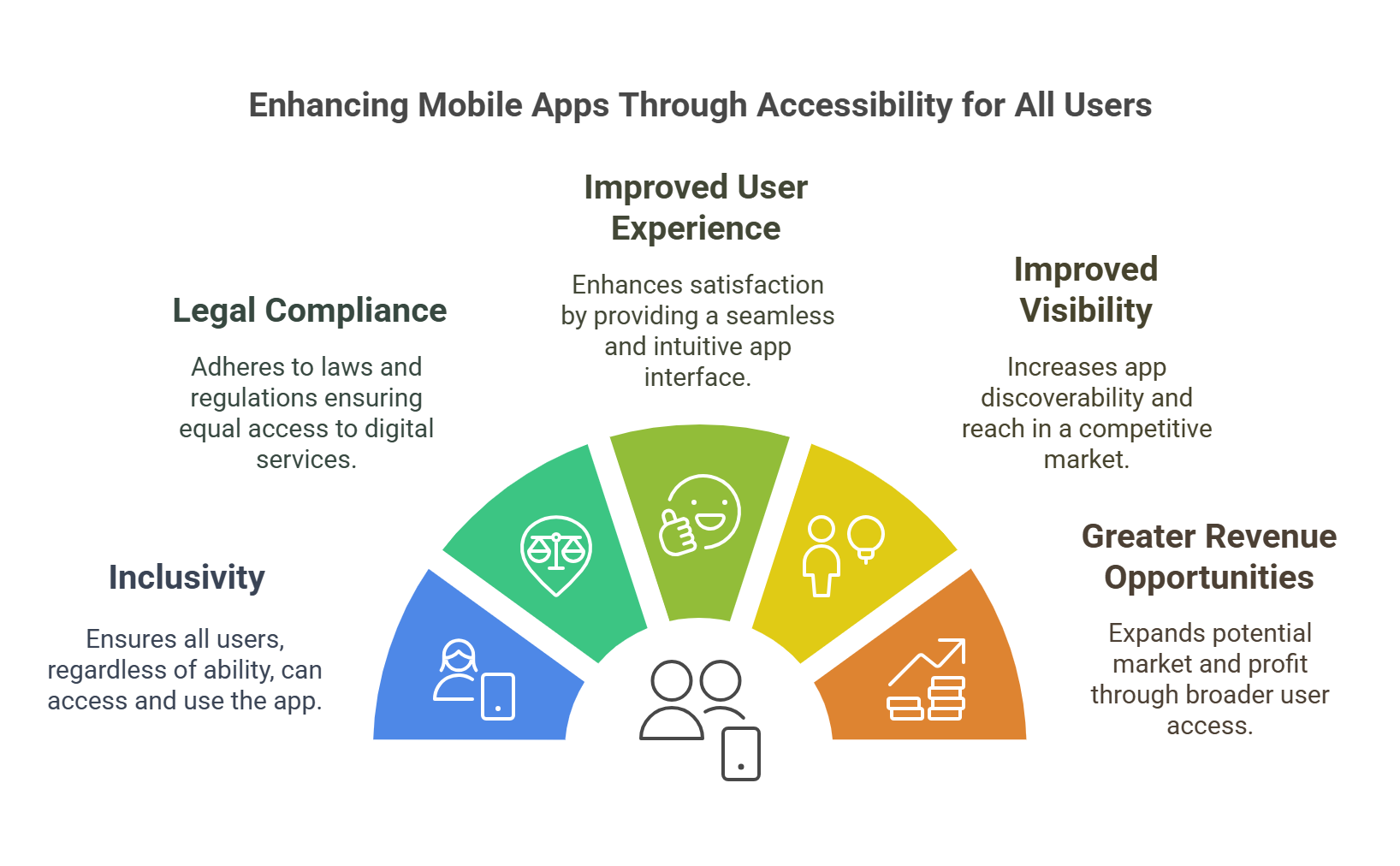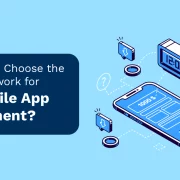
How Can You Choose the Right Framework for Better Mobile App Development?
Summary
Developing a mobile app requires the right framework, strong security, and accessibility considerations. This guide explores the best development frameworks, essential security practices, and accessibility guidelines to ensure apps are secure, inclusive, and high-performing. Learn how to build mobile applications that cater to all users while protecting data and privacy.
Mobile apps have become a crucial part of our daily lives, and brands invest heavily in developing apps to reach a broader audience. With over 6.93 billion smartphone users globally, the mobile app industry is booming.
Recent studies highlight the pervasive nature of smartphone usage, with Americans scrolling through their phones over 200 times daily. Statista projects the global market size of mobile apps to soar to $673 billion by 2027, boasting a noteworthy CAGR of 8.58%. These statistics underscore the indispensable role smartphones play in our lives.
If your app or platform is not mobile-optimized, you are likely missing out on a huge target group. An average user spent 5.19 hours daily on their smartphones in 2022, and 42.4% of this time is spent on mobile apps, only second to social media and communication platforms. Thus, most of your users will likely interact with your business on a mobile app instead of traditional mediums like a website.
Mobile application development services use different frameworks to customize the development process. This post will discuss the top mobile app strategies and frameworks and highlight insights into tools that empower developers to create innovative and efficient applications. Read on!
Table of Contents:
- What is a Mobile App Framework?
- What are the Types of Mobile Application Frameworks?
- Top 6 Mobile App Development Frameworks
- What is Mobile App Security, and What is its Significance?
- Mobile App Development: Common Security Issues
- Best Practices for Secure Mobile App Development
- What is Mobile App Accessibility?
- Challenges in Designing a Mobile Accessible App
- Top 5 Benefits of Mobile App Accessibility
- How to Design Mobile Apps that are Highly Accessible?
- Conclusion
What is a Mobile App Framework?
A mobile app framework is a platform or toolkit designed to create software. It includes programming interfaces, debugging tools, and other resources. Whether the developer is working on enterprise mobile application development or any other, using the framework can make the process easy.
Like toolkits for app builders, these frameworks provide a set of pre-made tools and guidelines to streamline the app production process. Consider them ready-to-develop tools to simplify the process and deliver it to the client. This not only accelerates development but also ensures consistency and efficiency throughout the project.
What are the Types of Mobile Application Frameworks?
Developers have different options for mobile app frameworks to meet the needs of the platforms. Some of these are-
1. Native Development Frameworks
It is platform-oriented, where developers can work on creating apps for a single platform using tools. The two best examples are-
- iOS App Development: Developers use Swift and Objective-C for iOS apps.
- Android Development: Developers use Java and Kotlin.
2. Cross-Platform Development Frameworks
These types of frameworks are best for apps for different platforms without using multiple codebases. Examples are:
- React Native: This Facebook product helps developers build mobile apps using React and JavaScript.
- Flutter: This Google product helps in developing cross-platform applications and UI frameworks.
3. Hybrid Mobile App Development Framework
It combines native and web technologies and relies majorly on web views to create content. The best examples are:
- Apache Cordova: Developers can use CSS, HTML, and JavaScript to create cross-platform app development.
- Ionic: It is best for hybrid app development.
Top 6 Mobile App Development Frameworks
Below are the top 6 mobile app frameworks that continue to shape the landscape of mobile app strategy:
1. Flutter
Flutter by Google is an open-source tool that helps developers create user-friendly app UIs. At present, its market share is 1.17% and growing. One unique thing about this framework is its ability to produce beautiful 2D elements—thanks to its extensive graphics library, appropriately titled “Skia.”
Interestingly, Flutter is designed using a combination of C, C++, and Dart, making it a flexible framework that works with a broad range of operating systems. With a single, well-balanced codebase, it works with Linux, Windows, iOS, and even Google’s futuristic Fuchsia OS.
Key Features:
- Continuous Updates and Improvements
- Customizable Widgets
- Native-Like User Experience
- Cross-Platform Compatibility
2. React Native
Many app developers use React Native to develop iOS and Android apps. Moreover, it uses JavaScript’s accuracy to enable developers to create applications that are compatible with both platforms.
React Native is a potent free tool for developers that works incredibly well across a variety of platforms—the whole gamut, including Windows, Mac, and Android. Some of the brands that use React Native for their apps are Skype, Amazon Prime, Tesla, and others. However, developers need to note down native code and make the best use of the platform’s languages when using React Native.
Key Features:
- Reusable components
- Native performance
- Live reload.
- Third-party plugin support
3. Ionic
This is yet another app framework that seamlessly runs on iOS and Android. This open-source mobile app is the best option if you are developing hybrid mobile apps. It uses CSS, HTML, and JavaScript for better results.
Using Angular and Apache Cordova (PhoneGap) in Ionic, developers have the freedom to develop Android and iOS apps that function together effortlessly.
The framework helps developers create reliable and feature-packed native apps. Thanks to Ionic’s most notable feature, Programmers can use various UI components, including filtering, inputs, navigation, views, and simple action sheets.
Key Features:
- Use of web technologies (CSS, JavaScript, HTML)
- A rich selection of UI elements and components
- Interactive forms
- Filter Options
4. Xamarin
Xamarin from Microsoft is a cross-platform open-source mobile application framework. It facilitates the development of state-of-the-art mobile applications by leveraging a software framework that encompasses programming languages like C# and Net.
Mobile applications developed using the Xamarin framework feature versatile native functionality that offers users an unparalleled user experience. Developers use Xamarin to create an ecosystem that includes a base, components, and more. In 2024, more mobile application development services will prefer using Xamarin.
Key Features:
- Code sharing across platforms.
- Integration with Visual Studio
- Wide range of libraries and tools
- Support for app testing and monitoring
5. Kotlin
Best for cross-platform applications, Kotlin is developed by JetBrains. Many mobile app developers are investing in Kotlin, especially those developing Android apps. One of the reasons is its integration with Java. Moreover, it has some good features, helping to create quality apps.
Key Features:
- Concise and expressive syntax
- Improved productivity
- Easy-to-learn language.
- Extensive Standard Library
6. Swiftic
Swiftic is a mobile app framework specifically designed for iOS that simplifies app creation by allowing developers to reuse online information rather than starting from scratch. This framework is highly adaptable for creating mobile applications as it offers a smooth user experience, specific banking, and straightforward methods.
Push notifications, feeds from social media platforms, app advertising, and other technological innovations are all part of the architecture. Given that you can design, install, and manage your app from a single control panel, it’s among the most user-friendly frameworks for app creation.
Key Features:
- Fast and efficient code execution
- Concise and expressive syntax
- Automatic memory management
- Enhanced safety with optional
What is Mobile App Security, and What is its Significance?
Mobile app security refers to a set of comprehensive strategies for safeguarding mobile applications and users’ digital identities from various cyber-attacks. It combines technical solutions with the implementation of best practices for app development.
But why is mobile app security so crucial?
As our dependence on mobile apps has increased, the risk of cyberattacks has surged. In fact, a cyberattack occurs every 39 seconds.
A single security breach can result in financial repercussions and lawsuits while adversely impacting the brand’s reputation. That’s why many businesses are taking mobile app security seriously.
This is what happens when your app development process is unsecured:
- Unprotected apps lead to data breaches
- Malicious applications can result in malware attacks
- Vulnerable to unauthorized access to confidential data
- Reputational damage
- Regulatory penalties
- Loss of intellectual property
Mobile App Development: Common Security Issues
The incidences of cyberattacks and data breaches continue to rise worldwide. Even as businesses strive to counter these issues, hackers are finding sophisticated ways to exploit loopholes in Android app development.
Knowing the potential threats is the first step to creating a comprehensive and watertight app security plan.
Here are some of the common security hazards that you should consider when building an app:
1. Malicious Malware
Did you know that around 17% of all data breaches happen due to malware attacks?
With the rise of e-commerce and banking apps, malware has become a major concern. Once it infiltrates the application, malware can stealthily target sensitive information, resulting in serious data breaches.
2. Phishing Attacks
Phishing scams have become increasingly sophisticated, ranging from fake messages to impersonating a user by hacking into their account. Scammers now employ advanced AI and machine learning to mimic fake messages or calls, making it difficult to figure out malicious requests.
Fake mobile banking apps are a primary example of phishing. These mobile apps often imitate the appearance and functionality of a legitimate app.
3. Insecure Authentication
Lack of robust authentication can pose a serious problem as it allows hackers to decode any type of complex password easily. In other words, insecure authentication provides a red carpet for fraudsters and cybercriminals to infiltrate the application. They can easily access sensitive user data, which makes them susceptible to serious crime.
Secure app development is an ongoing process that requires a proactive approach. By identifying possible dangers, you can implement measures to safeguard your assets and users.
Let’s see some of the best practices that mobile app developers should consider to make a cohesive mobile app strategy.
Best Practices for Secure Mobile App Development
As mobile apps become integral to our lives, ensuring their security has become paramount. Read on as we delve into proactive measures developers can take for secure Flutter app development.
1. Follow Airtight Coding Practices
Coding is the cornerstone of any mobile app development. Hence, its security becomes a top priority.
Secure coding protects the app’s core and makes it immune to cyberattacks such as cross-scripting, Man-in-the-Middle (MiTM), and Distributed Denial of Services (DDoS).
Consider the following points to safeguard your app development from cyberattacks:
- Protects your app against XSS and SQL injection by authenticating every user input.
- Grant limited access to the app’s functionality to bottleneck the possibilities of exposing system vulnerabilities.
- Scrutinize the codes to check for loopholes or discrepancies. Use both static and dynamic analysis for better results.
2. Enforce a Strong Authentication Process
User access points such as biometric authentication or screen locks are common cyberattack entry points.
So, what’s the best way to keep malicious elements at bay?
Follow a robust authentication process. This provides an extra layer of protection by ensuring only legitimate users can access the application.
While there are different authentication methods for secure app development, here are three main types:
- Multi-Factor Authentication (MFA): Ensure robust security by requiring users to offer multiple verification steps.
- Token-Based Authentication: This authentication process streamlines user access without uncovering user credentials.
- Session-Based Authentication: Automatic timeouts safeguard user sessions. Bank apps can use this method to protect critical data.
3. Robust Data Encryption
In the 21st Century, data is the new gold! And compromising its safety is non-negotiable. Robust data encryption ensures that confidential user information remains safe from hostile elements.
Here are a few points you should take into account while building an app:
- Ensure you encrypt critical data, whether stored or transmitted via the internet.
- Always store encryption keys securely, and if required, rotate them regularly.
- Use reliable storage methods such as secure cloud databases.
4. Regular Monitoring and Testing
The mobile app strategy landscape is evolving, and so are the dangers. Real-time monitoring and frequent app testing will keep the apps updated against the latest security hazards.
Here’s how you can test and update the mobile apps:
- Simulated cyberattacks will help you recognize loopholes before scammers can exploit them.
- Perform real-time monitoring to stay informed about any possible suspicious activities that may become a serious threat.
- Harness advanced technologies to scan inconsistencies and test the app for any hidden vulnerabilities.
5. Audit and Update Third-Party Libraries and SDKs
Unreliable and unprotected third-party components can lead to security vulnerabilities. So, how can we best ensure the safety of third-party libraries and SDKs?
Simple! When building an app, regularly audit the apps using reliable sources to see whether there are any weak links.
What is Mobile App Accessibility?
Mobile App Accessibility is a set of protocols that application designers and developers must abide by to ensure that their apps are easy to use and accessible to all, even those with disabilities. From using a screen reader to voice commands to interact with an app, adding alternative or additional usability can ensure that all users can make the most of your mobile application.
Mobile accessibility standards are often set and updated by several bodies and expert accessibility consultations, considering the unique needs of various individuals. This helps ensure that even people with disabilities, including visual, auditory, motor, or cognitive, can easily use and interact with your application.
This entire exercise aims to make digital content more accessible to all, regardless of their physical or cognitive limitations.
Challenges in Designing a Mobile Accessible App
Creating a mobile application is not rocket science, and many app developers can help you build a well-functioning app in a matter of days. However, just having an app is not enough.
Today, most businesses must manage multiple platforms and interaction channels, wherein mobile app accessibility is crucial.
This can be challenging to most due to factors such as:
1. Budget Constraints
Implementing mobile app accessibility features is crucial but requires time, resources, and costs. This added cost can lead to most companies skipping it altogether.
However, the investment in accessibility is a strategic one. Organizations should consider the return on investment and not just consider it a legal compliance measure. By viewing accessibility as a long-term investment, businesses can improve user experience and, thereby, revenue, making it viable for business success.
2. Lack of Awareness
One of the primary challenges businesses face is the lack of awareness about the importance of mobile app accessibility. Decision-makers may not fully understand the potential impact on user engagement and the bottom line. To overcome this, businesses must prioritize education and training for their teams.
Top 5 Benefits of Mobile App Accessibility
Being mobile-friendly doesn’t just help your application or website reach a sizeable audience; it has several other benefits, including the following:
1. Inclusivity
By designing apps that accommodate individuals with disabilities, you extend your reach to a larger user base, fostering a sense of belonging and equality. Since 1.3 billion people live with some form of disability, ensuring that your mobile app is easily accessible makes a significant impact in creating inclusive content.
2. Legal Compliance
Mobile app accessibility is also a norm per several regulatory requirements, including Web Content Accessibility Guidelines (WCAG), Americans with Disabilities Act (ADA), and other regulations. Several regions can have their legal requirements for digital accessibility.
By complying with these regulations, your app can avoid legal issues while enhancing your brand’s reputation.
3. Improved User Experience
Accessibility features don’t just help one section of the audience but benefit everyone. For example, captions and transcripts benefit not only people who are hard of hearing but also users who may be watching a video in a noisy environment.
4. Improved Visibility
Websites and apps that follow mobile app strategy and accessibility standards often get increased reach and improved ranking, be it search engines or the App Store. As more users engage and interact with your application, search engines and app stores will likely promote your app over your competition, ensuring you have better visibility.
5. Greater Revenue Opportunities
Mobile accessibility ensures that your content can be viewed on several devices and platforms, ensuring that people of all ages and requirements can use it. Therefore, you can reach a wider audience base and improve the likelihood of users trusting your brand. Consequently, you will generate additional revenue and profit while ensuring higher customer satisfaction and improved retention.
How to Design Mobile Apps that are Highly Accessible?
Ready to design a highly mobile-optimized app? While there are comprehensive mobile app accessibility testing checklists, here are a few simple steps that you can follow to be mobile-ready:
- Start by understanding the needs of your target audience, including individuals with disabilities. Work on user personas with various accessibility requirements to help guide your design process.
- Adhere to established accessibility guidelines such as the Web Content Accessibility Guidelines (WCAG) to ensure your app meets industry standards. These guidelines cover various considerations, from color contrast to keyboard navigation.
- Include alternative text for images, icons, and other non-text content. Screen readers rely on this information to describe visual elements to users with visual impairments.
- To make your app more accessible to individuals with hearing impairments, include captions for videos and transcripts for audio content.
- Regularly test your app and take feedback from your users, especially those with accessibility issues. Their feedback can go a long way in crafting accessible and user-friendly content.
- Pay attention to the cognitive aspects of accessibility, such as clear and concise content, consistent navigation, and avoiding overwhelming users with complex interfaces.
- Keep your app updated and address accessibility issues promptly. Technology evolves, and so do accessibility standards and best practices.
Conclusion
The world of app development is complex. With ever-evolving technologies, keeping cybercriminals at bay is a real challenge.
Thankfully, proactive measures, constant learning, and adapting to advanced tools can help you stay ahead of potential cyber threats.
At Hurix Digital, we understand that following best practices for mobile app security can be an uphill task. We are one of the leading companies with years of experience in Android app development, enterprise mobile app development, and Flutter app development.
Our team possesses the right experience and expertise in mobile app strategy and will guide you through the complicated mobile app security world.
Want to learn more? Schedule a call and our experts will provide feasible solutions.

Currently serving as the Vice President of Technology Delivery Operations at HurixDigital, a prominent global provider of digital content and technology solutions for publishers, corporations, and educational institutions. With over 16 years of experience spanning EdTech and various domains, I hold certification as a SCRUM Product Owner (CSPO). My expertise includes operations, finance, and adept people management skills.







